If you’re worried about everything you need to know to take part in your first tournament experience, never fear – Andrew Smith has a checklist of everything you need to do in advance and remember on the day
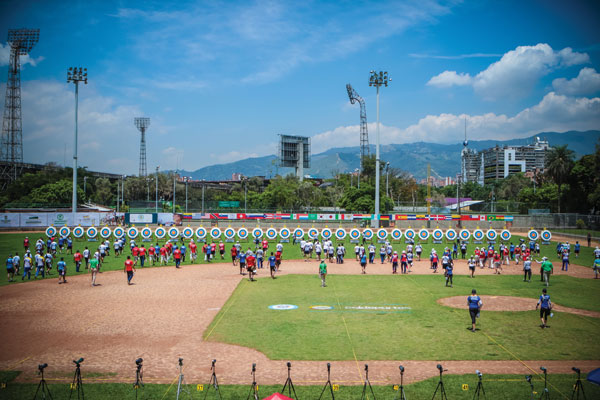
Competitions and tournaments can be very daunting…
In the weeks leading up to competition…
Weekly shooting schedule – It is stating the obvious to say the more you shoot the round leading up to the event the more archery fit you will be and the more confident you will be about your shooting form. But don’t train for the sake of it without giving 100 per cent to the session and each shot. When training always have a purpose, but keep it simple by working on only one issue at a time. Most top archers tend to scale down the number of arrows they shoot the week before a major tournament, but remember they also train every day. For the rest of us it is sometimes hard to find two nights a week, so the chances of over-training are slight.
Archers shoot competitions in all weathers providing it is not dangerous, so it’s also a good idea to train when it is raining, very hot or windy. This way, you will be familiar with shooting in different conditions and more able to cope on competition day, whatever the weather.
Something that is often overlooked is that often the fitter you are the better you will shoot, so any exercise you can fit in each week will be of benefit.

Check the forecast … then practise in your waterproofs anyway, as the British summer can be unpredictable
Make notes – If you don’t keep shooting notes, now is the time to start. In these notes you should record important information about each time you shoot. This should include sight marks – even how many clicks of adjustment from the norm it takes to adjust for the weather – practice conditions such as weather, wind direction, what you did and how you felt, along with any reminders to keep you focussed on shooting good shots.
Get your sight marks early – Points are lost by archers at all levels on the first end after a change of distance. It is important to get your sight marks weeks before a shoot; this way, you can check all the distances each time you practice. Due to the weather and how you are feeling, do not be surprised if they are marginally different each practice session. It is good to record these changes as they can be useful to make considered judgements during the competition. It is not unusual to find the sight marks on the day of the competition are slightly different, as not all fields are flat, and tree lines and pitch markings can create optical illusions.
Equipment – It is important that all your equipment is in good working order. Give yourself time to order spares and make repairs. Outdoors we shoot six arrows before collecting, so eight good, straight arrows for the day is really the bare minimum you need to allow for any damage or a lost arrow on the day. Check to make sure all your arrows group together – nothing is worse than a rogue arrow scoring lower than the other five each end. Some shoots require you to mark arrows with at least an initial to identify them as yours, so it is good practice to do it anyway. It’s the shafts that must be marked, not fletchings, as these can fall off.
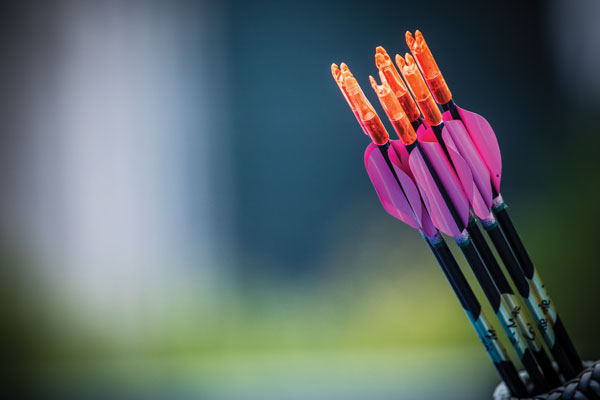
Prep your kit in advance – make sure you have enough arrows for the round and that they are numbered and initialled
Make sure nothing has come loose – Know all your bow’s measurements – bracing height, tiller, draw weight – before the day. Bracing height should always be checked after you’ve strung your bow and at least once after six arrows. It’s worth checking that nothing has come loose during practice. The tiller and draw weight are quick indicators by which you can check, and by knowing these measurements it is easy to put the bow back together correctly.
Spares – It’s good to have spares (a shot-in string and tab along with a button, arrow rest, armguard, chest guard and finger or wrist sling) as, outside of head-to-head rounds, time is given to archers to repair equipment. Tabs and finger slings can be dropped when walking to and from the target and it saves that walk of shame to collect them before shooting can recommence.
Location – Know where you are going, how you are going to get there, and how long it takes. Most archers like to arrive at least an hour before the assembly time to get a spot behind the tent line, get their equipment set up, and warm up.
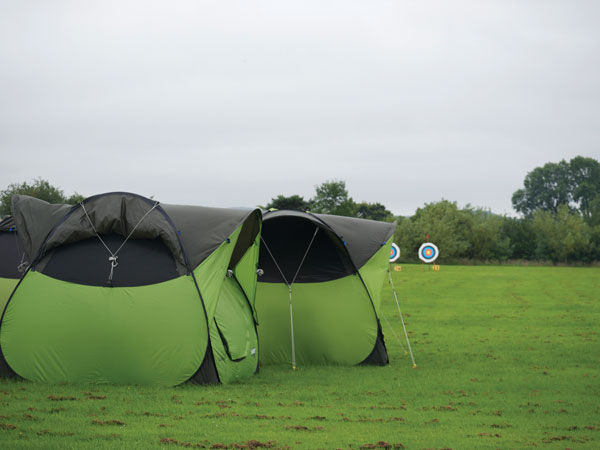
Getting to the venue with plenty of time to spare will let you get a shelter set up, get your equipment sorted, and warm up
Weather – Watch the forecasts leading up to the event, and then ignore what they say and prepare for all types of weather regardless. At the very least, always take waterproofs that you can shoot in and sun cream.
In the UK, you can bring your own shelter to outdoor archery tournaments, so you will see people with pop-up tents and large fishing umbrellas to protect themselves and their equipment from the elements.
Food – Elite athletes normally have a strict nutritional plan to follow, tailored to their body’s requirements up to and during the competition. I’d suggest you eat what you always do; your body is used to it and changes a few weeks before may upset your metabolism. This also applies during the competition; to look good there is an urge to fill plastic tubs with all manner of healthy looking food, but if your body is expecting something else it may rebel and make you feel worse. On the day of the competition you should keep to your routine as best you can. If you normally have breakfast then don’t skip it, and if that includes two or three cups of coffee, then fine – again, your body is expecting it.
Understand the shooting procedure – Find out and understand how the round you’ve selected is shot. Is it six-arrow ends, or three and three? Will there be timing lights and buzzers, or just a whistle? All this will just be one less thing to think about on the day.
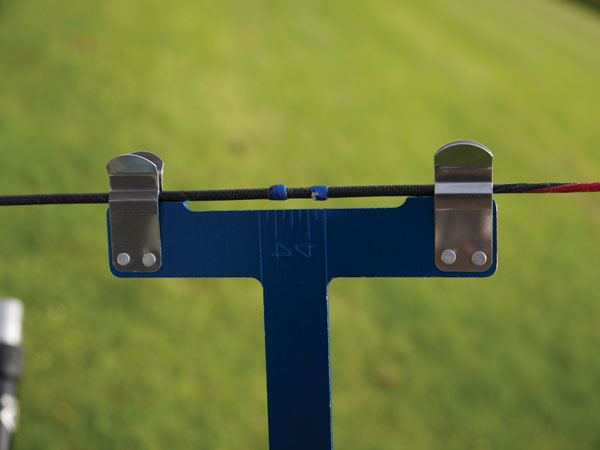
Get your bow’s measurements like brace height, tiller and nock point location so you can quickly identify if anything has shifted
The night before
Final preparation – Make a list of everything you are going to take, pack up all your equipment and check it at least twice to ensure that you have everything. I know of archers that have left risers, limbs, and even complete bows behind. Don’t forget your archery association membership card, too – without it most organisers will not let you shoot. If you are going to a new venue set the satnav or check you have good directions. Make your packed lunch and, finally, get a good night’s sleep. Staying up late might give you a ready-made excuse for not shooting well, but being tired and listless all day will not do you any favours.
The day of the shoot
At home – Get up in good time, have breakfast if that is what you normally do, make a packed lunch if you didn’t get the chance the night before, load the car, double-check you have everything, and set off – earlier than planned if possible, or at least on time.
Register and set up – When you arrive, go and register to find out your target number for the day, unload the car and set up as close as you can behind the tent line to your target number. Your priority is to get set up and make sure you check your bow is put together correctly. Under pressure it is quite easy to put your limbs or string on upside down, or forget to attach your button. Most importantly, check your bracing height and that you have set your sight for the first distance. There may be an equipment check (especially if it’s a World Record Status shoot) by the judges, otherwise, once you have set up you can socialise, take advantage of the catering, and wait for assembly.
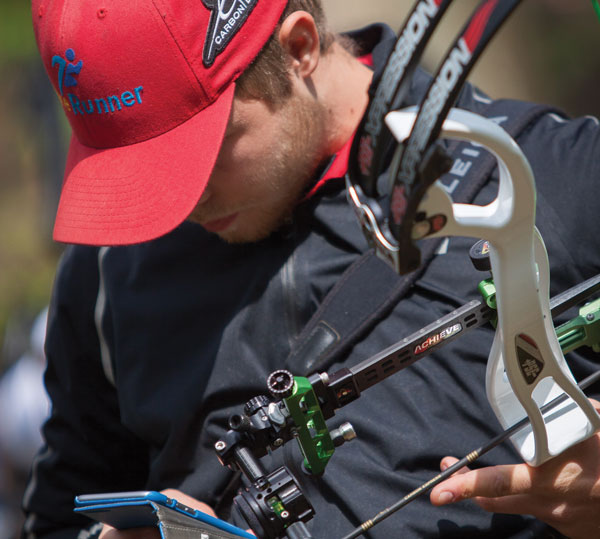
Get your sightmarks early and check them often to make sure they’re as reliable as they can be
Target companions – Make sure you find all your target companions early and agree where you are all going to stand on the shooting line. You may find that some archers have set up spotting scopes. Between you all, you need to make sure everyone is happy with where they are standing and nobody is being inconvenienced before the start of the shoot.
Shooting style – Competitions are not the place to try something new – save that for practice. There can be a temptation to look down the shooting line and marvel at some of the techniques on show and start to feel inadequate and look to replicate a different release or draw. During the shoot don’t worry about what others are scoring; you can do nothing about it, just concentrate on being relaxed and shooting normally. We are conditioned to see good arrows hitting the gold and if you look down the line your eyes will always focus on a good arrow that hits the gold. It may be the best arrow that archer has shot all day, but if you let your mind wander you can convince yourself that they are shooting better than you, even if their score at the end of the day confirms the opposite.
Avoid negativity or ‘what ifs’ – We are all guilty of taking competitions rather seriously on occasion, but remember we do this for fun, relaxation and to get away from the rigours of life. Competitions are a reality check, giving you feedback as to how well you are shooting and progressing. Unfamiliar shooting grounds, timing, and new target companions all take you out of your comfort zone. This means that your score might be lower than anticipated. As much as you like to think they do, nobody cares what you scored in the last end or that you are struggling with the wind, they are too pre-occupied with their own shooting. Nothing can be done about the arrows you have shot and scored, but keeping a positive attitude will have a big effect on the arrows you are yet to shoot. Negativity also affects the archers around you, which is perhaps why top archers with different competition agendas try to distance themselves from any negativity behind the shooting line. Be positive, even if you think you are not doing well. Others will be in the same boat and at the end of the day you still may shoot a PB, or even pick up a medal.
Recap – At the end of the shoot, after you have signed your scoresheet and thanked your target companions, find a few minutes to write down your observations about the day’s shooting before you forget. The day’s experience will help you improve next time, so list both the things that need working on and all the good points that you did well, as these must also be reinforced on the practice field ready for the next competition.
This article originally appeared in the issue 120 of Bow International magazine. For more great content like this, subscribe today at our secure online store: www.myfavouritemagazines.co.uk

